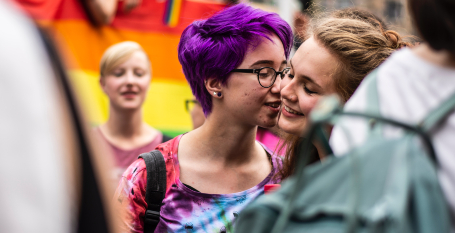More than 1-in-10 young women in the UK identify as lesbian, gay, bisexual or other, according to latest population statistics.
Of females aged 16-24, 11.4% said they were lesbian, gay, bisexual or other based on an annual population survey by the Office for National Statistics that relates to 2020. It is the first time since the research began in 2014 that the percentage has breached the 10% mark.
In 2014, only 3.1% of young women identified that way – fewer than young men – but they now far outstrip them, with the largest group of those not identifying as heterosexual – 7.6% – saying they are bisexual.
But that number falls considerably after the age of 24 when it declines to 2% from age 25-34 and further still to less than 1% at ages above that.
The figures clearly show an accelerating openness among people of all ages over 16 about their sexual orientation and come after Jake Daniels became the UK’s first male professional footballer to come out publicly as gay since 1990.
Advertisement
The figures showed the proportion of people of all genders in the UK identifying as lesbian, gay or bisexual almost doubled in six years, with the latest jump taking the proportion from 2.7% in 2019 to 3.1% in 2020.
Advertisement
The survey suggests 1.65 million people identify as lesbian, gay or bisexual, with a further 350,000 saying “other”. That equates to more than 800,000 additional over-16s identifying that way since 2014.
The areas of the UK where people were most likely to say they were heterosexual were Northern Ireland, followed by the east of England. The regions with the highest number of people not identifying as heterosexual, including declining to reveal their sexual orientation, were London, Yorkshire and the north-west.
There were also differences based on ethnicity, with mixed race people over 16 least likely to identify as straight or heterosexual. Asian and British Asian people were most likely not to say when asked.
Of females aged 16-24, 11.4% said they were lesbian, gay, bisexual or other based on an annual population survey by the Office for National Statistics that relates to 2020. It is the first time since the research began in 2014 that the percentage has breached the 10% mark.
In 2014, only 3.1% of young women identified that way – fewer than young men – but they now far outstrip them, with the largest group of those not identifying as heterosexual – 7.6% – saying they are bisexual.
But that number falls considerably after the age of 24 when it declines to 2% from age 25-34 and further still to less than 1% at ages above that.
The figures clearly show an accelerating openness among people of all ages over 16 about their sexual orientation.
The figures showed the proportion of people of all genders in the UK identifying as lesbian, gay or bisexual almost doubled in six years, with the latest jump taking the proportion from 2.7% in 2019 to 3.1% in 2020.
The survey suggests 1.65 million people identify as lesbian, gay or bisexual, with a further 350,000 saying “other”. That equates to more than 800,000 additional over-16s identifying that way since 2014.
The areas of the UK where people were most likely to say they were heterosexual were Northern Ireland, followed by the east of England. The regions with the highest number of people not identifying as heterosexual, including declining to reveal their sexual orientation, were London, Yorkshire and the north-west.
There were also differences based on ethnicity, with mixed race people over 16 least likely to identify as straight or heterosexual. Asian and British Asian people were most likely not to say when asked.

